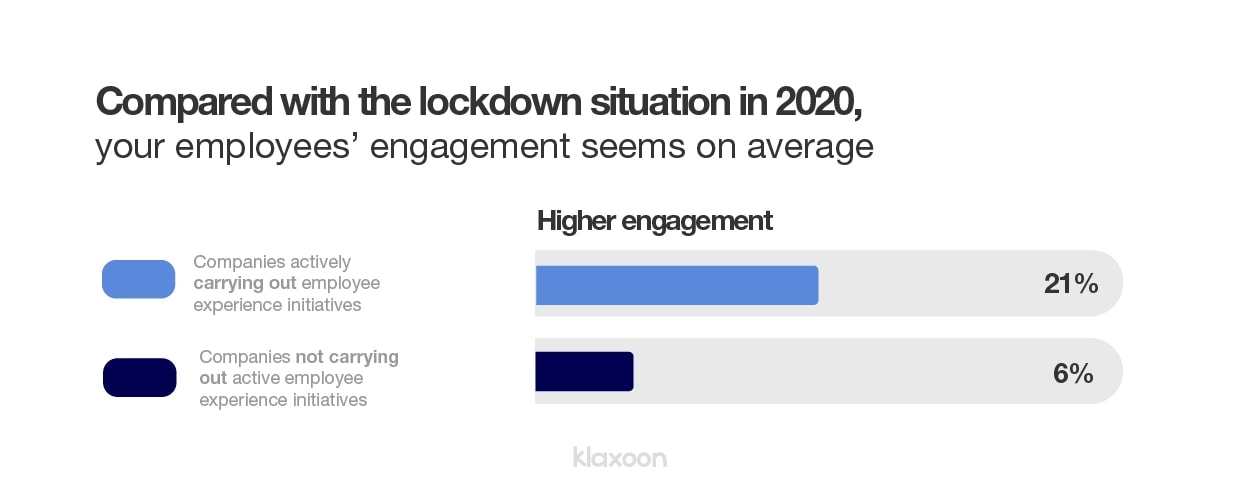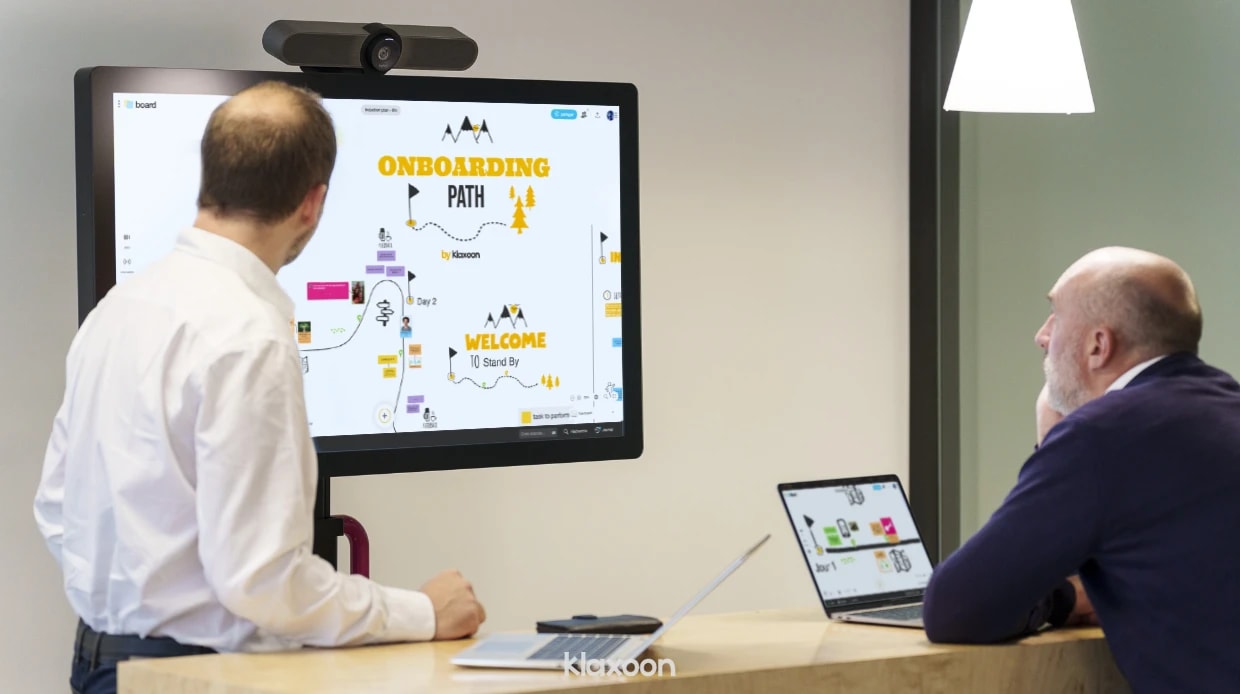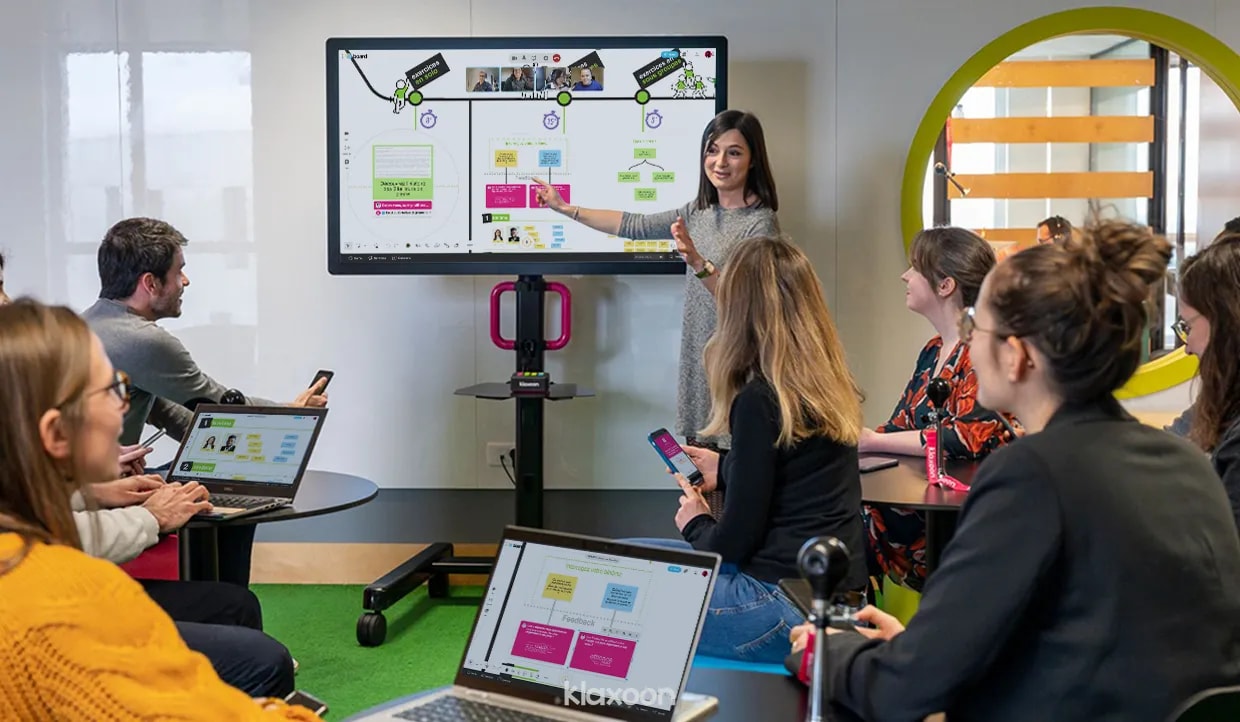What exactly is employee experience?
Published on February 14, 2025
What exactly is employee experience?
Taking inspiration from customer experience, employee experience keeps employees happy at work. What does it look like and how can it be improved? Let’s try to find out!
Imagine this. You go into a store with the intention of buying something. Once inside, no one greets you, the music is deafening and all your questions remain unanswered. After walking round in circles for ten minutes waiting for someone to deign to help you, you end up walking out, most likely feeling disappointed and frustrated. You have just had a bad customer experience.
Now imagine the same scenario, but in your work environment. In other words, every day, you find yourself in the office, or on your own at home, feeling abandoned, without anyone to talk to or the information you need to work effectively. You would be having a bad employee experience.
While the concepts of customer experience and even user experience, so-called UX, are generally accepted and used by companies to ensure a good service quality, employee experience as a concept is much less well-known. Moreover, according to the 2022 Parlons RH barometer, only 1 in 2 companies has implemented best practices for enhancing their employee experience. But that’s nothing new. A good employee experience is above all a way of ensuring employee engagement and improving everyone's performance.
In simple terms, employee experience represents all the interactions and experiences of employees at work, from the moment they're hired until they leave. It’s a complex sum of formal and informal events and moments that constitute a whole package. While employee experience is a concept that stems from studies relating to human resources, from a practical point of view, it now covers everything that employees do.
This ranges from team rituals to one-on-ones, from onboarding programs to informal discussions at the water cooler. It concerns ways of working, production and interpersonal relationships at work. So, it’s a very comprehensive and diverse package.
While by definition, employee experience is not new, studying it is. It was first studied in the late 2000s. And these studies stemmed directly from those relating to customer experience, as their guiding principles are quite similar.
For any business, creating a positive customer experience is like a complicated pool shot. As well as helping to close a sale, it can also create a positive brand image and have a long-term impact on the company's reputation. Clearly, customer experience impacts how dynamic your business is. The same goes for employee experience, according to a concept called symmetry of attention.
This principle of symmetry of attention is a fairly recent concept. Developed 15 years ago, it starts from the premise that the quality of a company's relationship with its customers directly mirrors the quality of its relationship with its employees. In other words, the more you take care of your employees, the more they will take care of your customers. And then, you will enter a virtuous circle.
This principle was developed and put into practice in the late 2000s by Vineet Nayar, an Indian entrepreneur in the IT services sector, in his book Employees First, Customers Second, published in 2010. In his book, he recounts how his staff experienced autonomy and trust-based management. And the results were very impressive: 20% more revenue growth, and 70% employee satisfaction! That’s a good example of a win-win deal.
Actually, this is quite a logical correlation. How can you convince your employees that they must adopt a positive and caring attitude toward customers, in accordance with the company’s principles, if the company does not apply them to the staff themselves? "Do what I say, not what I do." No, thank you.
For a company, thinking about employee experience in these terms is bound to improve satisfaction, motivation and above all engagement from all the employees.
Keep in mind that the latest national employee experience barometer (2022), conducted by the French cabinet Parlons RH, explains that about 50% of responding companies have adopted a proactive approach and initiatives for improving their employee experience.
The difference in terms of engagement is a reality. According to the report, employees from companies carrying out employee experience initiatives saw a higher level of engagement, compared to those working in companies with no dedicated initiatives.


The figures speak for themselves: companies that focus on their employee experience have an engagement rate more than 3 times higher than others.
As a speaker at a webinar organized by Klaxoon, Isabelle Rich Van Hoorne, a partner at the ConvictionsRH French cabinet, shared her definition of employee experience:
It’s about creating valuable moments, from the first day, and even before they’re hired. Valuable moments, to communicate the company’s culture and DNA, and meet the employee’s expectations. It’s about being in synch, together.
"Being in synch" is another way of talking about engagement, and reciprocity between the company and the employee. This synchronization occurs through different types of interactions: key milestones, essential stages in the employee lifecycle, but also some informal moments. It means giving employees the space to express themselves, and feel valued.
The power of rituals is well-proven to improve employee engagement. Academic research has focused on the importance of milestones in the employee journey within a company. From the moment they’re hired, 1 in 3 executives has resigned, as a result of poor onboarding. Every stage is important. Isabelle Rich Van Hoorne agrees, talking about immersing employees in the company at every stage: "Obviously, there's the hiring process which is a key moment, and these procedures are evolving. It’s about onboarding and everything we create within the company: wellbeing at work, team moments, or so. There are employee assessments and career management too. How, in the future, can we embed employees in the organization to retain them for as long as possible? Finally, there’s the offboarding process, preparing for an employee departure. It doesn’t matter that an employee wants to do something else, but we must take care of them at this time, because there are consequences."


The onboarding process needs to present visually all the information your new hires would need.
It is this comprehensive support at each milestone that will maximize employee engagement with their company. Let’s take one-on-ones, for example. Frequency, effectiveness and transparency, as the essential qualities of a good one-on-one meeting, play a major role in the sense of belonging for employees. This is one of the findings of the study conducted jointly by Professor Steven Rogelberg from the University of North Carolina, author of The Surprising Science of Meetings, and Klaxoon.
Similarly, continuous learning, as the feeling of continuing to learn every day at work, helps to maximize team engagement.
A report commissioned by the human resources specialists Glint confirms this. According to the latter, employees who have good training and development opportunities within their organization are on average:
In short, training contributes to talent wellbeing and retention – two important aspects of a positive employee experience initiative.
Interviewed as part of the Parlons RH barometer, Bertrand Duperrin, Head of People and Business Delivery at Emakina, adds another dimension to employee experience: "There is always a risk of confusing employee experience with quality of work life. More often than not, when we talk about QWL and wellbeing, we’re talking about all the things that are nothing to do with work: the environment, the premises, the services... But employee experience is first and foremost about everything that happens when the employee is working. It’s not just a question of asking what can be done to be nice to them when they’re not working. Employees want us to address the sources of stress, not compensate for the distress they create."
A bad employee experience also means not being able to express yourself, and the frustration and misunderstanding that can impact a mission or project. Like pebbles in your shoe, you have to get rid of them.
To engage your teams, you must also think about daily life, and give your talented employees the means and tools they need to flourish. In the first place, this involves everyone being able to express any point of view. Offer alternatives so people can give their opinion. Today, nearly 50% of people are afraid to speak up in meetings, which naturally makes them frustrated and demotivated.


Feeling listened to is essential for a good employee experience, whatever our favorite form of expression is.
Similarly, adapting to the needs is also part of a successful employee experience initiative, be it time to think about a project or the ability to work from anywhere, any time. Julie Achili, Head of Employee Experience at Nestlé France, agrees: "We are developing more initiatives based on "care", agility and work-life balance."
There are new opportunities for collaboration and participation, thanks to the growth of hybrid work and asynchronous work. This agility makes it possible to get everyone on board for each initiative.
This is an important trend in the Parlons RH baromete,r and the main source of change for talent: the hybrid work model. This transformation involves many different jobs and means rethinking our ways of working.
And to achieve this, we have to co-create these new ways of working to get the backing of everyone involved. This is what the company Lecko does with its organizational transformation. As Christophe Routhieau, one of the firm’s directors, explains: "There was a sense of weariness on the part of managers, especially because they were working remotely. So, it was important to talk about it, to get them all on board. To do this, we capitalized on their experience to identify the right actions to carry out."
Imposing a new working model is not the solution to offer an ambitious, and above all sustainable employee experience. On the other side, active listening and employee participation are both essential to define an efficient new model. Here again, it will result in avoiding frustration and any disappointment.
Finally, to develop a good employee experience in a hybrid culture, think about using simple methods to structure your approach, and above all take inspiration from what has worked well elsewhere.
For example, at Sogecap, a subsidiary of the French bank Société Générale, Aurore Delannoy uses a ready-to-use Onboarding process, from Klaxoon’s template library. She uses it mainly to support employees returning to work after long-term absence, to make it easier to resume their job. In terms of employee experience, this process increases engagement and provides reassurance for the people who follow it. As Aurore herself explains: "For the participants, it’s fun, it covers everything and it saves them time. When they come back, they’re less stressed. They know where they're going thanks to the visuals and planner. They have some time by themselves and at the same time they’re supported, they know they can contact us."
Similarly, nowadays, it’s easy to manage your team remotely with the right tools, and more generally to understand all the employee’s valuable moments:
All these things are possible with the right tools. Because they are one of the keys to success in a hybrid world.
In a Hybrid World, Your Tech Defines Employee Experience. It’s all in the title of this article published in Harvard Business Review. The reality of the hybrid world has sometimes passed employees by, and needed them to adapt to remote working and new ways of collaborating. This article refers to a study, which found that only 30% of employees feel satisfied with the tools their company provides. And according to Microsoft, 4 out of 10 employees currently lack essential office supplies. Moreover, 10% don’t have an adequate internet connection to do their job.
According to another study by Qualtrics, employees are 230% more engaged and 85% more likely to stay beyond 3 years in their jobs if they feel they have the right technology that supports them at work. Having useful, functional and appropriate tools contributes significantly to make a good employee experience. This fosters a culture of inclusion, facilitates the way teams work and helps retain talent.
With the right methods and tools, you too will have the keys to develop a good employee experience for the benefit all your employees.
Unlock your teamwork potential